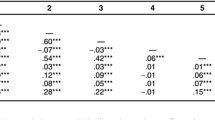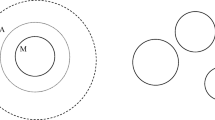Abstract
Cleveland and McGill [10] concluded that dot plots are effective when one judges position along a common scale. We assessed the ability of graph readers to detect sample mean differences in multipanel dot plots. In Experiment 1, plots containing vertically arranged panels with different sample sizes and levels of variability were presented. Sensitivity was greater with large samples and low variability. In Experiment 2, sensitivity depended on the location of the comparison sample, with vertical and superimposed arrays yielding greater sensitivity than horizontal or diagonal arrays. Horizontal arrays also produced a bias to judge data in right-most panels as having higher means. Experiment 3 showed that ordering of data had little effect on sensitivity or bias. The results suggest that good graph design requires attention to how the specific features of a graphical format influence perceptual judgments of data
Preview
Unable to display preview. Download preview PDF.
Similar content being viewed by others
References
Bazerman, C.: Theoretical integration in experimental reports in twentieth-century physics: Spectroscopic articles in physical review, 1893-1980. In: Bazerman, C. (ed.) Shaping Written Knowledge, pp. 153–186. University of Wisconsin Press, Madison (1988)
Butler, D.L.: Graphics in psychology: Pictures, data, and especially concepts. Behav. Res. Meth. Instrum. Comput. 25, 81–92 (1993)
Chambers, J.M., Cleveland, W.S., Kleiner, B., et al.: Graphical methods for data analysis. Wadsworth & Brooks/Cole, Pacific Grove (1983)
Cleveland, W.S.: The elements of graphing data (rev. ed.). AT&T Bell Laboratories, Murray Hill (1994)
Cleveland, W.S.: Visualizing data. AT&T Bell Laboratories, Murray Hill (1993)
Cleveland, W.S.: The elements of graphing data. Hobart Press, Summit (1985)
Cleveland, W.S.: Graphical methods for data presentation: Full scale breaks, dot charts, and multibased logging. Am Stat. 38, 270–280 (1984)
Cleveland, W.S.: Graphs in Scientific Publications. Am Stat. 38, 261–269 (1984)
Cleveland, W.S., Diaconis, P., McGill, R.: Variables on scatterplots look more highly correlated when the scales are increased. Science 216, 1138–1141 (1982)
Cleveland, W.S., McGill, R.: Graphical perception and graphical methods for analyzing scientific data. Science 229, 828–833 (1985)
Cleveland, W.S., McGill, R.: An experiment in graphical perception. Int. J. Man Mach. Stud. 25, 491–500 (1986)
Gigerenzer, G., Murray, D.J.: Cognition as intuitive statistics. Erlbaum, Hillsdale (1987)
Graham, J.L.: Illusory trends in the observations of bar graphs. J. Exp. Psychol. 20, 597–608 (1937)
Green, D.M., Swets, J.A.: Signal Detection Theory and Psychophysics. Wiley, New York (1966)
Hankins, T.K.: Blood, dirt, and nomograms: A particular history of graphs, pp. 50–80. ISIS (1999)
Hollands, J.G., Spence, I.: Judgments of change and proportion in graphical perception. Hum. Factors 34, 313–334 (1992)
Holmes, F.L., Olesko, K.M.: The images of precision: Helmholtz and the graphical method in physiology. In: Wise, M.N. (ed.) The Values of Precision, pp. 198–221. Princeton University Press, Princeton (1995)
Kosslyn, S.M.: Graph design for the eye and mind. Oxford University Press, New York (2006)
Kosslyn, S.M.: Elements of graph design. W. H. Freeman, New York (1994)
Kosslyn, S.M.: Cognitive neuroscience and the human self. In: Harrington, A. (ed.) So Human a Brain: Knowledge and Values in the Neurosciences, pp. 37–56. Birkhaeuser, Boston (1992)
Krohn, R.: Why are Graphs so Central in Science? Biol. Philos. 6, 181–203 (1996)
Latour, B.: Drawing things together. In: Lynch, M., Woolgar, S. (eds.) Representation in Scientific Practice, pp. 19–68. MIT Press, Cambridge (1990)
Legge, G.E., Gu, Y., Luebker, A.: Efficiency of graphical perception. Percept Psychophys. 46, 365–374 (1989)
Lewandowsky, S., Spence, I.: Discriminating strata in scatterplots. J. Am. Stat. Assoc. 84, 682–688 (1989)
Licklider, J.C.R.: Theory of signal detection. In: Swets, J.A. (ed.) Signal Detection and Recognition by Human Observers: Contemporary Readings, pp. 95–121. Wiley, New York (1964)
Macmillan, N.A., Creelman, C.D.: Detection Theory: A User’s Guide. Cambridge University Press, New York (1991)
Peden, B.F., Hausmann, S.E.: Data graphs in introductory and upper level psychology textbooks: A content analysis. Teach. Psychol. 27, 93–97 (2000)
Poulton, E.C.: Geometric illusions in reading graphs. Percept. Psychophys. 37, 543–548 (1985)
Sasieni, P.D., Royston, P.: Dotplots. 45, 219–234 (1996)
Schutz, H.G.: An evaluation of formats for graphic trend displays: Experiment II. Hum. Factors 3, 99–107 (1961)
Smith, L.D., Boynton, D.M., Stubbs, D.A.: Intuitive statistics as signal detection: Perceptual judgments of sample differences. Poster presented at the meeting of the American Psychological Association, Boston, MA (1990)
Smith, L.D., Stubbs, D.A., Best, L.A.: Graphical illusion in multipanel dot plots: Method-of-adjustment analysis. Paper presented at the American Psychological Association Annual Meeting, Honolulu (2004)
Smith, L.D., Best, L.A., Cylke, V.A., et al.: Psychology without p Values: Data Analysis at the turn of the 19th century. Am. Psychol. 55, 260–263 (2000)
Smith, L.D., Best, L.A., Stubbs, D.A., et al.: Constructing knowledge: The role of graphs and tables in hard and soft psychology. Am. Psychol. 57, 749–761 (2002)
Spencer, J.: Estimating averages. Ergonomics 4, 317–328 (1961)
Sternberg, R.J.: The psychologist’s companion: A guide to scientific writing for students and researchers, 3rd edn. Cambridge University Press, Cambridge (1993)
Tukey, J.W.: Data-based graphics: Visual display in the decades to come. Stat. Sci. 5, 327–339
Wainer, H.: Visual Revelations: Graphical Tales of Fate and Deception from Napoleon Bonaparte to Ross Perot. Copernicus, New York (1997)
Wainer, H., Velleman, P.F.: Statistical graphics: Mapping the pathways of science. Annu. Rev. Psychol. 52, 305–335 (2001)
Author information
Authors and Affiliations
Editor information
Rights and permissions
Copyright information
© 2008 Springer-Verlag Berlin Heidelberg
About this paper
Cite this paper
Best, L.A., Smith, L.D., Stubbs, D.A. (2008). Detection of Sample Differences from Dot Plot Displays. In: Stapleton, G., Howse, J., Lee, J. (eds) Diagrammatic Representation and Inference. Diagrams 2008. Lecture Notes in Computer Science(), vol 5223. Springer, Berlin, Heidelberg. https://doi.org/10.1007/978-3-540-87730-1_27
Download citation
DOI: https://doi.org/10.1007/978-3-540-87730-1_27
Publisher Name: Springer, Berlin, Heidelberg
Print ISBN: 978-3-540-87729-5
Online ISBN: 978-3-540-87730-1
eBook Packages: Computer ScienceComputer Science (R0)




